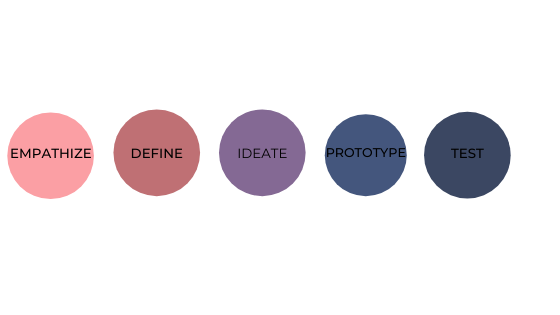What Lawyers Can Learn From Designers

If you’ve spent any time around me recently, you’ve probably heard me talking about Design Thinking. I first heard about Design Thinking a couple of years ago and I’ve been hooked ever since.
What is Design Thinking?
Design thinking is the mindset designers use when they are trying to make or improve a product, service or experience. Until recently, design thinking was the bailiwick of people who designed physical products – think the iPhone. But as the service industry grows, more people are turning to design thinking as a way to improve customer experiences – from delivering health care in the home to designing meaningful celebrates. There are a few different definitions of the components of design thinking, but most versions reflect five components: empathy, define, ideate, prototype and test. It is a fluid, non-linear process and designers often revisit each component – something like this:

There are a few things that set this process apart:
- Questions – Designers ask a lot of questions. They are not afraid to challenge assumptions and revisit their definition of the problem. Designers understand reaching a viable solution is as much about asking the right questions as it is about getting things “right.”
- Creativity – Designers favor quantity of ideas over quality. They value ideas that seem wild at first because those “crazy” ideas can actually translate into doable solutions.
- Detaching – Designers stay open to new ideas and alternatives instead of getting stuck on one solution – or even one problem. There is no room for judgment or falling in love with one idea too soon.
- Human Centered – Designers understand that they are creating products and services for humans. They want their designs to solve real problems for real people.
But I’m a Lawyer (Accountant/Advisor/Coach…) I Don’t Design Stuff
Really? Let me ask a few questions:
- Do you work with humans?
- Are your clients human?
- Do you understand the value of asking the right question?
- Do you solve problems for a living?
- Would your clients benefit from creative solutions?
I’m guessing you can answer yes to at least one or two of these questions (unless, of course you represent monkeys in their case against the elephants.) In which case, you can adopt a design thinking approach to many facets of practicing law. Just a few examples:
The Client’s Journey: Clients come to us to solve their problems and to do this well, we need to understand not just the question that brings them in the door, but the full picture of how they found themselves in their situation and what their goals are. In other words, we are better lawyers when we start where designers start – with empathy.
Fact Finding: Would you ever walk into a deposition and ask only one question? I doubt it. Those T-funnels we learned in law school closely mirror the design thinking process. Designers start broad, narrow down in one area and then widen it out at the “bottom” to test assumptions and understand where the gaps remain – more like an X than a T and perhaps more effective.
Retaining Talent: This is a hot topic these days as firms try to position themselves as supportive of minorities. Firms spend money to recruit diverse candidates, they invest in affinity groups and special mentors and sponsors. I’ve seen all of this in my 20 years of practice, but the needle of diversity at the higher levels of firms has hardly moved. If firms took the time to gain empathy for potential hires, to really understand what matters most to them – and moved through the design thinking process, I think we would see real, sustainable change.
Bias to Action: This one may be tough for lawyers because we are naturally risk averse and most of us prefer to have all the facts and law carefully researched before we act. Designers, on the other hand, are excited to try stuff, even before its fully fledged. So maybe you don’t want to “try stuff” without doing some homework in most legal situations, sometimes taking bold, unexpected actions can benefit our clients. The action may be asking for “outside the box” terms in a deal or settling a case for something other than money.
Learning Opportunities: Lawyers hate to fail. Some take it personally; others get angry at office furniture or disproportionately criticize themselves. What if we looked at mistakes the way designers do? Designers do not fail – they learn and do better with better information for next time. Sure, it doesn’t feel good to make a mistake, but a mistake is totally pointless if we can’t learn from it.
Design thinking is one of the key pillars for my work with clients. I believe that we can apply the designer’s mindset for our careers and the rest of our lives. When we do, we remain open to the possibilities. If you’re wondering what’s possible for you, consider putting on your designer’s hat and joining my group coaching program, the Board of Direct-hers.
